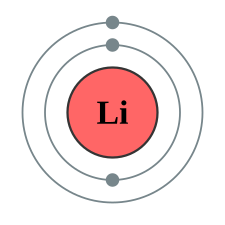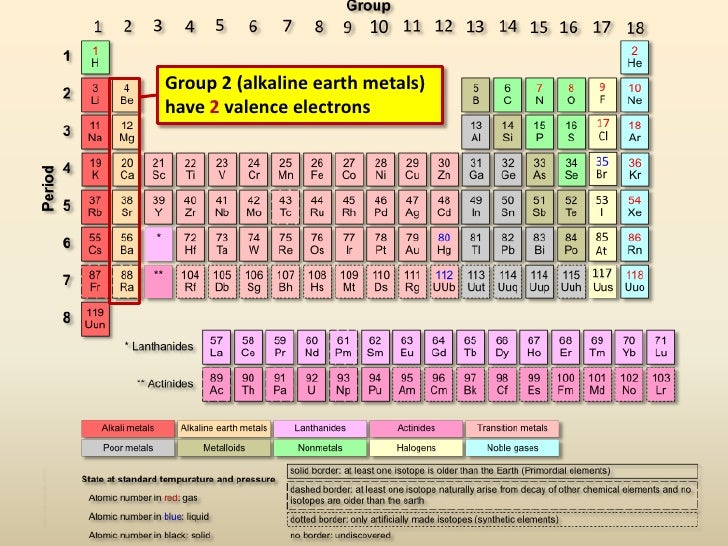In 1869, the Russian chemist Dmitri Mendeleev first proposed that the chemical elements exhibited a 'periodicity of properties.' Mendeleev had tried to organize the chemical elements according to their atomic weights, assuming that the properties of the elements would gradually change as atomic weight increased. What he found, however, was that the chemical and physical properties of the elements increased gradually and then suddenly changed at distinct steps, or periods. To account for these repeating trends, Mendeleev grouped the elements in a table that had both rows and columns.
The number of electrons in an electrically-neutral atom is the same as the number of protons in the nucleus. Therefore, the number of electrons in neutral atom of Lithium is 3. Each electron is influenced by the electric fields produced by the positive nuclear charge and the other (Z – 1) negative electrons in the atom. A way to find valence electrons without the periodic table is using the atomic number and drawing a diagram. The atomic number is how many protons and electrons the atom has. That means an atomic number of 8 (oxygen), has 8 protons and 8 electrons. Let’s draw it out as a simple diagram. Imagine the atom is a set of circles, with a dot in the. Lithium has 1 valence electron and since it is a metal it looses its valence electrons to become stable. If it looses and electron it now has 3 protons and 2 electrons therefore there is 1 more.
Practice: Use Atom Builder to create a neutral atom of each of the following elements. Draw an electron dot diagram for each. Remember, only valence electrons are shown in dot diagram. H He Li Be B C N O F Ne 6. Extend your thinking: Many properties of an element are determined by the number of valence electrons. Which element probably has similar properties to lithium?

Arrangement of the modern periodic table
The modern periodic table of elements is based on Mendeleev's observations; however, instead of being organized by atomic weight, the modern table is arranged by atomic number (z). As one moves from left to right in a row of the periodic table, the properties of the elements gradually change. At the end of each row, a drastic shift occurs in chemical properties. The next element in order of atomic number is more similar (chemically speaking) to the first element in the row above it; thus a new row begins on the table.
For example, oxygen (O), fluorine (F), and neon (Ne) (z = 8, 9 and 10,respectively) all are stable nonmetals that are gases at room temperature. Sodium (Na, z = 11), however, is a silver metal that is solid at room temperature, much like the element lithium (z = 3). Thus sodium begins a new row in the periodic table and is placed directly beneath lithium, highlighting their chemical similarities.
Rows in the periodic table are called periods. As one moves from left to right in a given period, the chemical properties of the elements slowly change. Columns in the periodic table are called groups. Elements in a given group in the periodic table share many similar chemical and physical properties.

Comprehension Checkpoint
Why does sodium appear directly below lithium in the periodic table?
Electron configuration and the table

The 'periodic' nature of chemical properties that Mendeleev had discovered is related to the electronconfiguration of the atoms of the elements. In other words, the way in which an atom's electrons are arranged around its nucleus affects the properties of the atom.
Niels Bohr's theory of the atom tells us that electrons are not located randomly around an atom's nucleus, but they occur in specific electron shells (see our Atomic Theory II module for more information). Each shell has a limited capacity for electrons. As lower shells are filled, additional electrons reside in more-distant shells.
The capacity of the first electron shell is two electrons and for the second shell the capacity is eight. Thus, in our example discussed above, oxygen, with eight protons and eight electrons, carries two electrons in its first shell and six in its second shell. Fluorine, with nine electrons, carries two in its first shell and seven in the second. Neon, with ten electrons, carries two in the first and eight in the second. Because the number of electrons in the second shell increases, we can begin to imagine why the chemical properties gradually change as we move from oxygen to fluorine to neon.
Sodium has eleven electrons. Two fit in its first shell, but remember that the second shell can only carry eight electrons. Sodium's eleventh electron cannot fit into either its first or its second shell. This electron takes up residence in yet another orbit, a third electron shell in sodium. The reason that there is a dramatic shift in chemical properties when moving from neon to sodium is because there is a dramatic shift in electron configuration between the two elements. But why is sodium similar to lithium? Let's look at the electron configurations of these elements.
As you can see in the illustration, while sodium has three electron shells and lithium two, the characteristic they share in common is that they both have only one electron in their outermost electron shell. These outer-shell electrons (called valence electrons) are important in determining the chemical properties of the elements.
An element's chemical properties are determined by the way in which its atoms interact with other atoms. If we picture the outer (valence) electron shell of an atom as a sphere encompassing everything inside, then it is only the valence shell that can interact with other atoms – much the same way as it is only the paint on the exterior of your house that 'interacts' with, and gets wet by, rain water.
The valence shell electrons in an atom determine the way it will interact with neighboring atoms, and therefore determine its chemical properties. Since both sodium and lithium have one valence electron, they share similar chemical properties.
Comprehension Checkpoint

The chemical properties of an element are determined by the number of electrons in
Electron configuration shorthand
For elements in groups labeled A in the periodic table (IA, IIA, etc.), the number of valenceelectrons corresponds to the group number. Thus Li, Na, and other elements in group IA have one valence electron. Be, Mg, and other group-IIA elements have two valence electrons. B, Al, and other group-IIIA elements have three valence electrons, and so on. The row, or period, number that an element resides in on the table is equal to the number of total shells that contain electrons in the atom. H and He in the first period normally have electrons in only the first shell; Li, Be, B, and other period-two elements have two shells occupied, and so on. To write the electron configuration of elements, scientists often use a shorthand in which the element's symbol is followed by the element's electron shells. A few examples are shown below.

Valence Battery Company
| Element Configuration Shorthand | ||||
|---|---|---|---|---|
| Element | Configuration Shorthand | |||
| Hydrogen | H | 1e- | ||
| Lithium | Li | 2e- | 1e- | |
| Fluorine | F | 2e- | 7e- | |
| Sodium | Na | 2e- | 8e- | 1e- |
Number Of Electrons In Lithium Valence Shell
For further details, the table linked below shows the electronconfigurations of the first eleven elements.
Summary
The modern periodic table is based on Dmitri Mendeleev’s 1896 observations that chemical elements can be grouped according to chemical properties they exhibit. This module explains the arrangement of elements in the period table. It defines periods and groups and describes how various electron configurations affect the properties of the atom.
